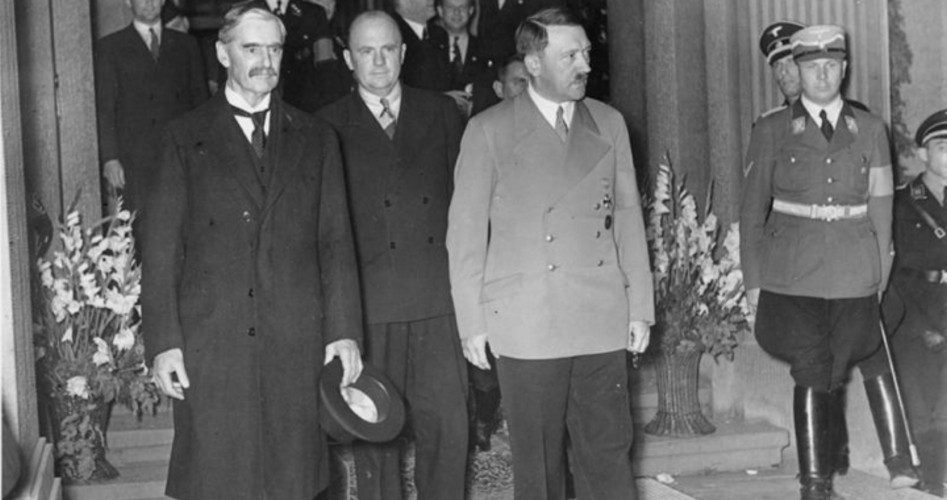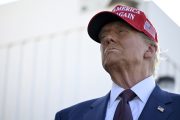
Anyone who has followed the events of the past several years, including the neocon wars of George “Napoleon” Bush and the wars the McCain-Graham-Lieberman axis longed for, cannot have missed the fact that in Washington, it is always 1938 and every tyrant who crosses a border or even attempts to put down a rebellion in his own land is the latest in a long line of Hitlers. And to round out the picture, anyone who opposes premature military engagements against the real or imagined aggressor has been accused of being another Neville Chamberlain (shown left front, with Adolf Hitler).
It’s really a simple, age-old story. If you want a war, you can convince the peasantry that they are threatened by some tyrant thousands of miles and an ocean or two away. One of the lessons Richard Nixon is said to have learned from Soviet leader Nikita Khrushchev is that if the people imagine a river, the wise statesman does not attempt to convince the people there is no river there. Instead, he builds an imaginary bridge. And government propagandists can induce the people to imagine a river. It is the same principle as the emperor’s new suit in the timeless tale by Hans Christian Andersen. And if someone chooses to believe his own eyes instead of the government propaganda, he is denounced as a knave or worse. He might even be called another Neville Chamberlain.
For those not familiar with the history, Chamberlain, the British prime minister, traveled to Munich to meet with Hitler in 1938 after Hitler had proved contemptuous of the artificial borders created at Versailles at the end of World War I. The German army had lately moved into Czechoslovakia, and Chamberlain was eager to get an agreement from the German chancellor that Poland and other nations would be spared the assault of the German blitzkrieg. Hitler was willing to sign such an agreement and when he did, Chamberlain returned home declaring he had secured “peace in our time.”
Hitler, of course, was not restrained by the piece of parchment he had signed, and England was drawn by the guarantee it had given to Poland into its second war with Germany in a generation. Chamberlain’s name has been synonymous with appeasement ever since. And as it happened, it was either raining or threatening rain while he was in Munich, so the prime minister carried an umbrella with him. Alas, the poor umbrella has also become a symbol of appeasement. So much so that legend has it that when President Eisenhower returned from a summit with Khrushchev on a rainy day in Washington in 1955, Vice President Nixon put out the word that there would be no umbrellas carried by any in the entourage of dignitaries who would greet the president at the airport.
That would not be the last or the least of the hauntings of Neville Chamberlain on the minds of Western, and especially American, statesmen. The high point of the Cold War came when it was discovered that the Soviet Union was erecting offensive nuclear weapons in Cuba, 90 miles from the southern coast of Florida. As President Kennedy informed a nervous nation on October 22, 1962, nuclear bombs from those missiles would be capable of striking much of the United States. It was a clear violation of the Monroe Doctrine, which was, of course, a declaration by a long-dead U.S. president and had no basis in international law. Still, the United States by then had long since crafted a number of interlocking treaties of the type Washington and Jefferson denounced as “entangling alliances,” with European allies, as well as with neighboring nations in Latin America. And the policy of deterring the Soviet Union had reached the status of political gospel. The Soviets were clearly invading our turf and John F. Kennedy was not going to play Neville Chamberlain.
But neither would he, as his brother, Attorney General Robert Kennedy, insisted, be the Tojo of the 1960s, referring to the Japanese general who had ordered the attack on Pearl Harbor. The United States could have bombed the missile sites in Cuba, but it is hardly likely that could have been done without some retaliation by the Soviets, if not from Cuba, then perhaps, as President Kennedy feared, in Berlin, where the presence of NATO forces deep within communist East Germany had long been a sore point with the Soviets.
So had the presence of U.S. missiles ringing the Soviet Union, including in militarized Greece and Turkey, two nations that had been added to the original dozen NATO members in the 1950s. U.S. missiles in Turkey were as provocative to the Soviets as their missiles in Cuba would be to the United States, notwithstanding that the former were considered part of the status quo balance of power, while the latter were considered a dangerous upsetting of the Cold War apple cart.
To further complicate things, Kennedy, unknown to Khrushchev, had already ordered the missiles removed from Turkey, on the grounds, it has since been reported, that they had grown obsolete. And unknown to Kennedy, the military had not complied with his orders. So while the world teetered on the brink of a nuclear war, the two superpowers came to a sensible agreement. The United States would take its missiles out of Turkey, and the Soviets would pack up their missiles in Cuba and ship them home.
Except that the shadow of Neville Chamberlain hovered over the outbreak of peace. The United States would not admit it had made a concession to avoid war. Domestic politics would not allow it. We must not make concessions to what Ronald Reagan would later correctly dub the “evil empire.” So while the removal of the missiles from Cuba had to be public — otherwise there would be no way to call off the highly publicized Cuban Missile Crisis — the other part of the bargain, the removal of U.S. missiles from Turkey, had to be a secret. It would not happen for another six months and the Soviets must promise to keep that part of the agreement secret. So at great embarrassment to Moscow, policymakers in Washington could say, as Secretary of State Dean Rusk did, that the United States stood in an eyeball-to-eyeball nuclear confrontation with the Soviets and it was the communists who “blinked.”
There was, later reports revealed, also a secret guarantee that the United States, following the Bay of Pigs fiasco 18 months earlier, would not attempt or abet an invasion of Cuba. That put the United States in the position of protecting Cuba from coastal raids by Cuban exiles based in the United States. That infuriated anti-Castro Cubans and, depending on what assassination theory one might believe, it could be seen as the burning sense of betrayal that contributed to the chain of events that ended with the bullets that killed President Kennedy in Dallas, Texas, exactly 13 months after the formal beginning of the missile crisis.
President Kennedy came out of that crisis appearing to be the strong-willed leader who would not bow to the Soviets’ aggressive and intimidating designs. But the question seldom asked was why had the situation become a full-blown crisis, threatening nuclear annihilation, in the first place. At the beginning, Kennedy was apparently unaware that he still had the Turkey missiles as a bargaining chip. But why could he not have found that out before making a dramatic address to the nation, an emergency meeting of the United Nations, and the sense of urgency and alarm that nearly set off World War III? If memory serves, the Washington-to-Moscow hot line, a direct line from the White House to the Kremlin, was not installed until after the missile crisis. But it seems inconceivable that at the beginning of the crisis the president of the United States could not have reached the leader of the Soviet Union by phone, even without the hot line. It would no doubt have been embarrassing for the president to learn from his counterpart in the Soviet Union that he still had missiles in Turkey because his own military had ignored his orders to remove them.
“What? I’ve got missiles in Turkey? The hell, you say!”
Perhaps it was believed that no amount of negotiation could have persuaded the Soviets to remove the missiles until they were embarrassed by the publicity and the extent to which world opinion had been galvanized against them. Or, as seems at least as likely, the political establishment in Washington could not resist the temptation to prove that the Ivy League intellectuals of Kennedy’s “Camelot” were tough enough to take on the Russians in a nuclear game of what Republican former Secretary of State John Foster Dulles had dubbed “brinkmanship,” a game of political “chicken.” The other guy “blinked.”
So who really was the hero of the Cuban Missile Crisis? Khrushchev was willing to keep the secret of the missile bargain and accept the world’s judgment that the Soviets had backed down in the face of overwhelming American determination and might, rather than turn down a one-sided settlement that would avoid at best a prolonged stalemate in the Caribbean, rivaling the stalemate of Soviet vs. NATO forces on land in Europe or, at worst, a nuclear war. Because he pulled back from the brink, Khrushchev lost face with his own generals and was within two years deposed as the leader in the Kremlin.
Victory, President Kennedy said after the Bay of Pigs, has a thousand fathers. Defeat is always an orphan. Kennedy, at tremendous cost to himself, was able to make an orphan of Khrushchev. Just who got back at Kennedy and why remains a mystery, ever to be explored by students of the president’s assassination. What has gone underappreciated is the extent to which the shadow of Neville Chamberlain hung over American foreign policy throughout the Cold War and nearly led to full-scale nuclear war “in our time.”



